manual transmission TOYOTA TACOMA 2012 Owners Manual (in English)
[x] Cancel search | Manufacturer: TOYOTA, Model Year: 2012, Model line: TACOMA, Model: TOYOTA TACOMA 2012Pages: 628, PDF Size: 12.11 MB
Page 2 of 628

TABLE OF CONTENTSIndex
2
1-1. Key informationKeys ..................................... 34
1-2. Opening, closing and locking
the doors
Wireless remote control ....... 36
Side doors ............................ 39
Access doors (Access Cab models only) ....................... 43
Tailgate ................................ 44
1-3. Adjustable components
(seats, mirrors, steering
wheel)
Front seats ........................... 49
Rear seats (Access Cab and Double Cab models) .......... 54
Head restraints ..................... 58
Seat belts ............................. 63
Steering wheel ..................... 69
Anti-glare inside rear view mirror .................................. 70
Outside rear view mirrors ..... 75
1-4. Opening and clos ing
the windows
Pow er windows .................... 78
Back window (vehicles with sliding type) ........................ 80
1-5. Refueling Opening the fuel tank cap .... 81 1-6. Theft deterrent system
Engine immobilizer system ... 84
1-7. Safety information Correct driving posture ......... 87
SRS airbags ......................... 89
Front passenger occupant classification system ......... 103
Child restraint systems ....... 108
Installing child restraints ..... 112
2-1. Driving procedures Driving the vehicle .............. 132
Engine (ignition) switch....... 143
Automatic transmission ...... 146
Manual transmission........... 150
Turn signal lever ................. 153
Parking brake ..................... 154
Horn .................................... 156
2-2. Gauges and meters Gauges and meters ............ 157
Indicators and warning lights ................................. 160
2-3. Operating the li ghts and
wipers
Headlight switch ................. 164
Fog light switch ................... 167
Windshield wipers and washer .............................. 168
1Before driving
2When driving
Page 18 of 628
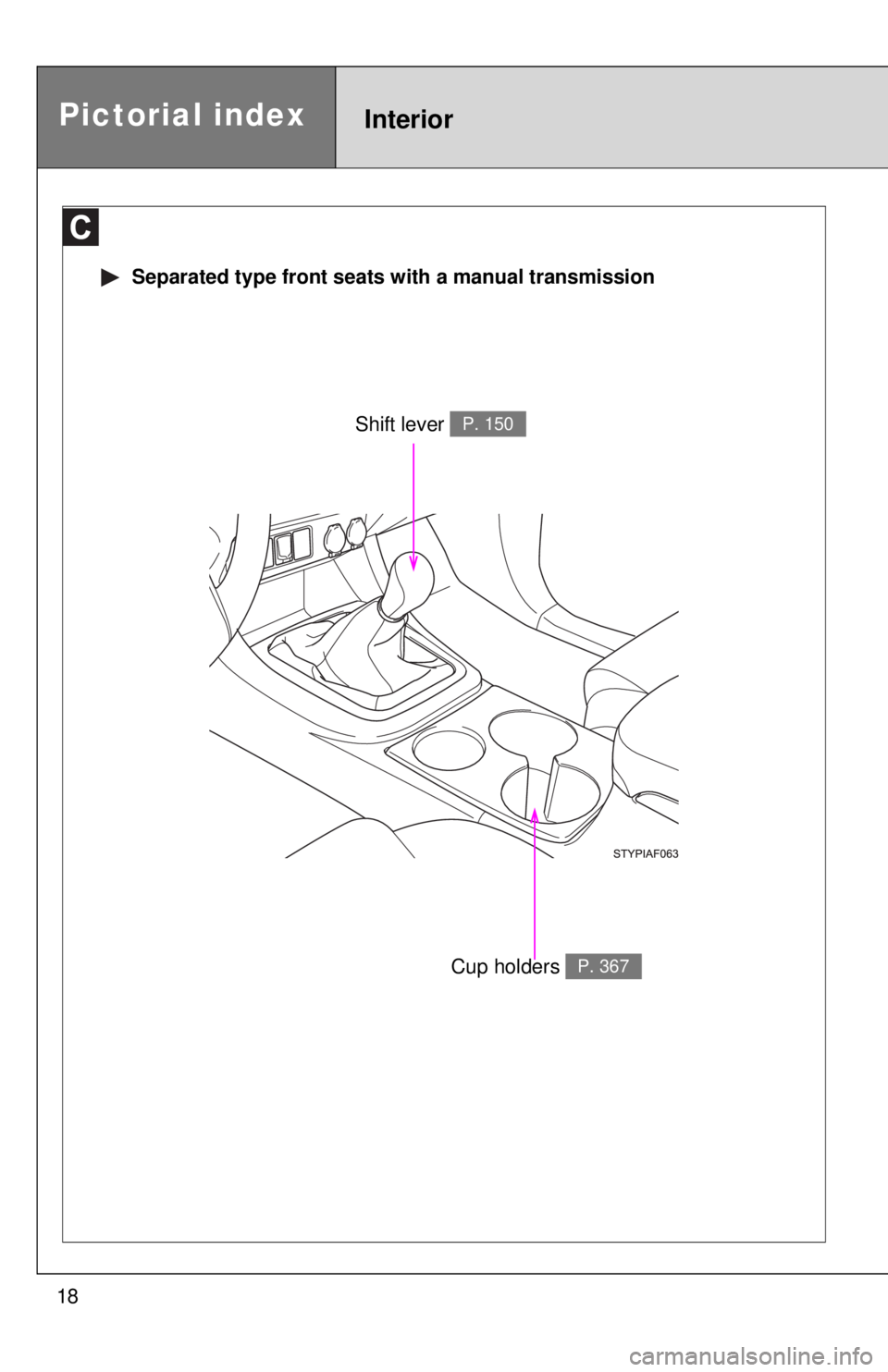
18
Separated type front seats with a manual transmission
Shift lever P. 150
Cup holders P. 367
Pictorial indexInterior
Page 23 of 628
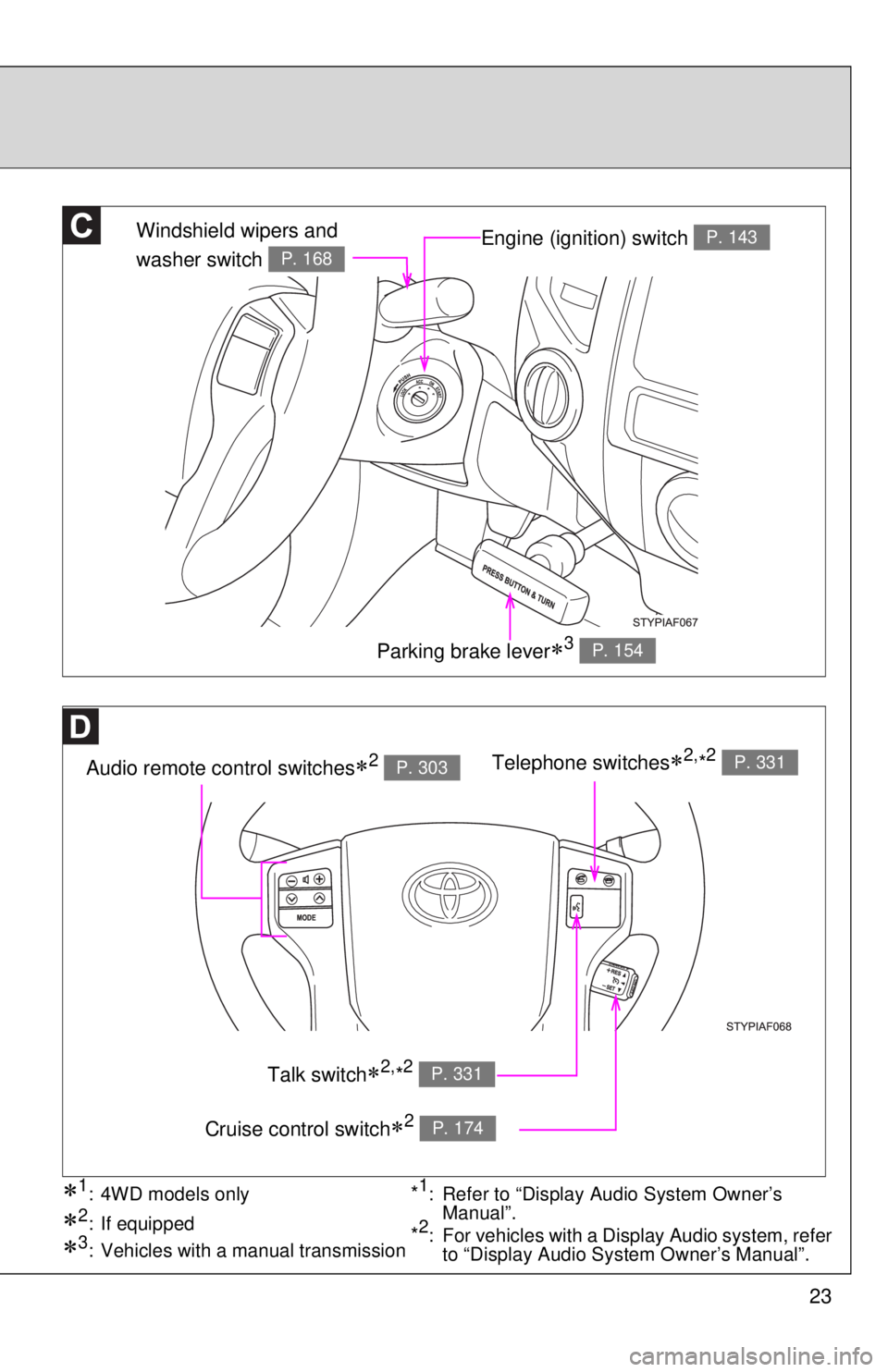
23
Engine (ignition) switch P. 143
Audio remote control switches2 P. 303
Windshield wipers and
washer switch
P. 168
Parking brake lever3 P. 154
Telephone switches2,*2 P. 331
Talk switch2,*2 P. 331
Cruise control switch2 P. 174
3: Vehicles with a manual transmission
1: 4WD models only
2: If equipped
*1: Refer to “Display Audio System Owner’s
Manual”.
*2: For vehicles with a Display Audio system, refer to “Display Audio System Owner’s Manual”.
Page 29 of 628

29
Vehicle control and operation data recording
Your Toyota is equipped with sophisticated computers that record certain
information about your vehicle’s operation, such as:
• Engine speed
• Accelerator status
• Brake status
• Vehicle speed
• Shift position (except manual transmission)
The data recorded varies according to the grade level and options the vehi-
cle is equipped with. The computers do not record conversations, sound or
pictures.
●Data usage
Toyota may use the data recorded in these computers to diagnose malfunc-
tions, conduct research and development, and improve quality.
Toyota will not disclose the recorded data to a third party except:
• With the consent of the vehicle owner or with the consent of the lessee if the vehicle is leased
• In response to an official request by the police, a court of law or a govern- ment agency
• For research purposes where the data is not tied to a specific vehicle or vehicle owner
● Event data recorder
This vehicle is equipped with an event data recorder (EDR). The main pur-
pose of an EDR is to record, in certain crash or near crash-like situations,
such as an air bag deployment or hitting a road obstacle, data that will assist
in understanding how a vehicle’s systems performed. The EDR is designed
to record data related to vehicle dynamics and safety systems for a short
period of time, typically 30 seconds or less.
The EDR in this vehicle is designed to record such data as:
• How various systems in your vehicle were operating;
• Whether or not the driver and passenger safety belts were buckled/fas- tened;
• How far (if at all) the driver was depressing the accelerator and/or brake pedal; and,
• How fast the vehicle was traveling.
Page 131 of 628
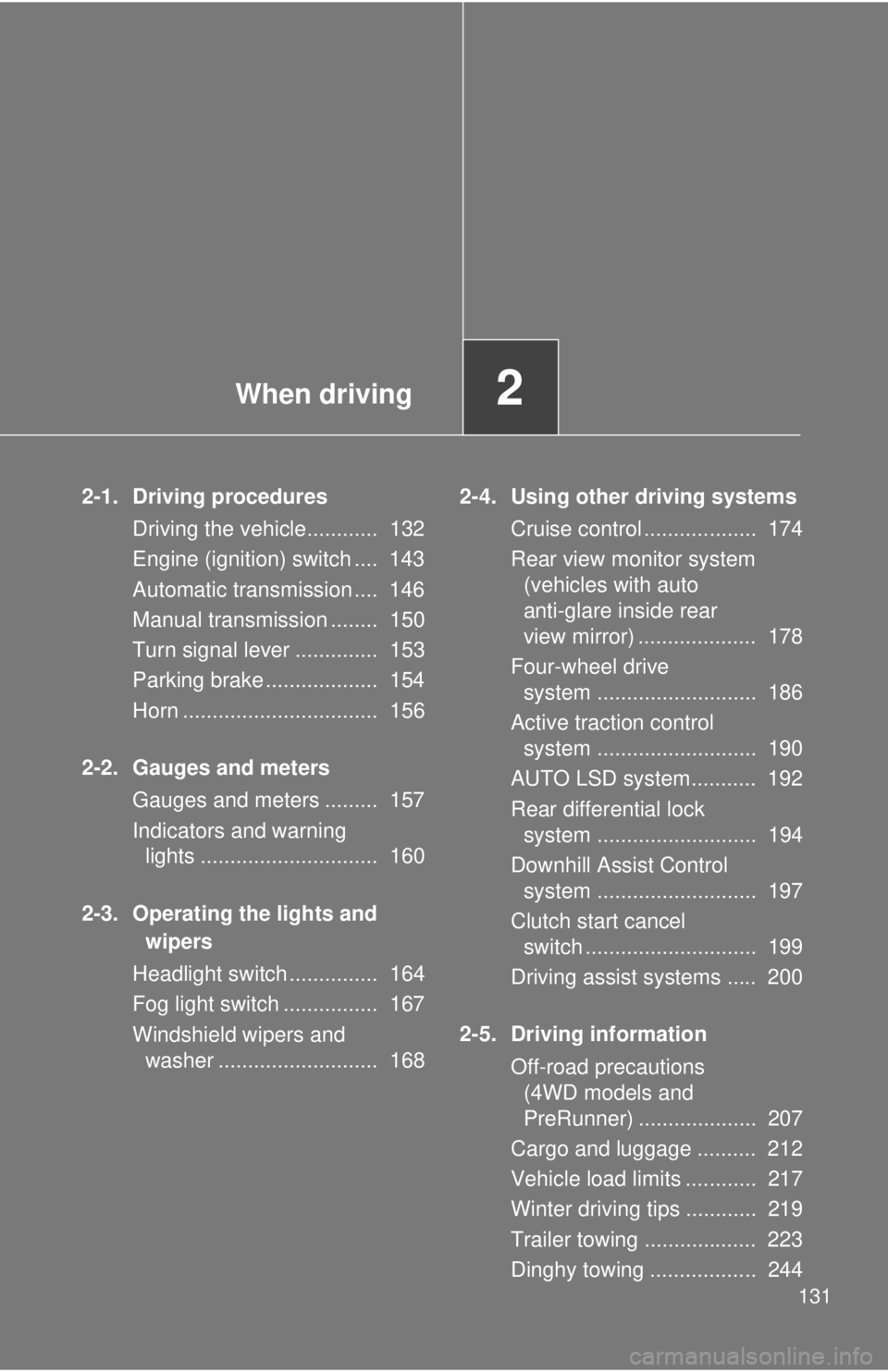
When driving2
131
2-1. Driving proceduresDriving the vehicle............ 132
Engine (ignition) switch .... 143
Automatic transmission .... 146
Manual transmission ........ 150
Turn signal lever .............. 153
Parking brake ................... 154
Horn ................................. 156
2-2. Gauges and meters Gauges and meters ......... 157
Indicators and warning lights .............................. 160
2-3. Operating the lights and wipers
Headlight switch ............... 164
Fog light switch ................ 167
Windshield wipers and washer ........................... 168 2-4. Using other driving systems
Cruise control ................... 174
Rear view monitor system (vehicles with auto
anti-glare inside rear
view mirror) .................... 178
Four-wheel drive system ........................... 186
Active traction control system ........................... 190
AUTO LSD system........... 192
Rear differential lock system ........................... 194
Downhill Assist Control system ........................... 197
Clutch start cancel switch ............................. 199
Driving assist systems ..... 200
2-5. Driving information Off-road precautions (4WD models and
PreRunner) .................... 207
Cargo and luggage .......... 212
Vehicle load limits ............ 217
Winter driving tips ............ 219
Trailer towing ................... 223
Dinghy towing .................. 244
Page 132 of 628
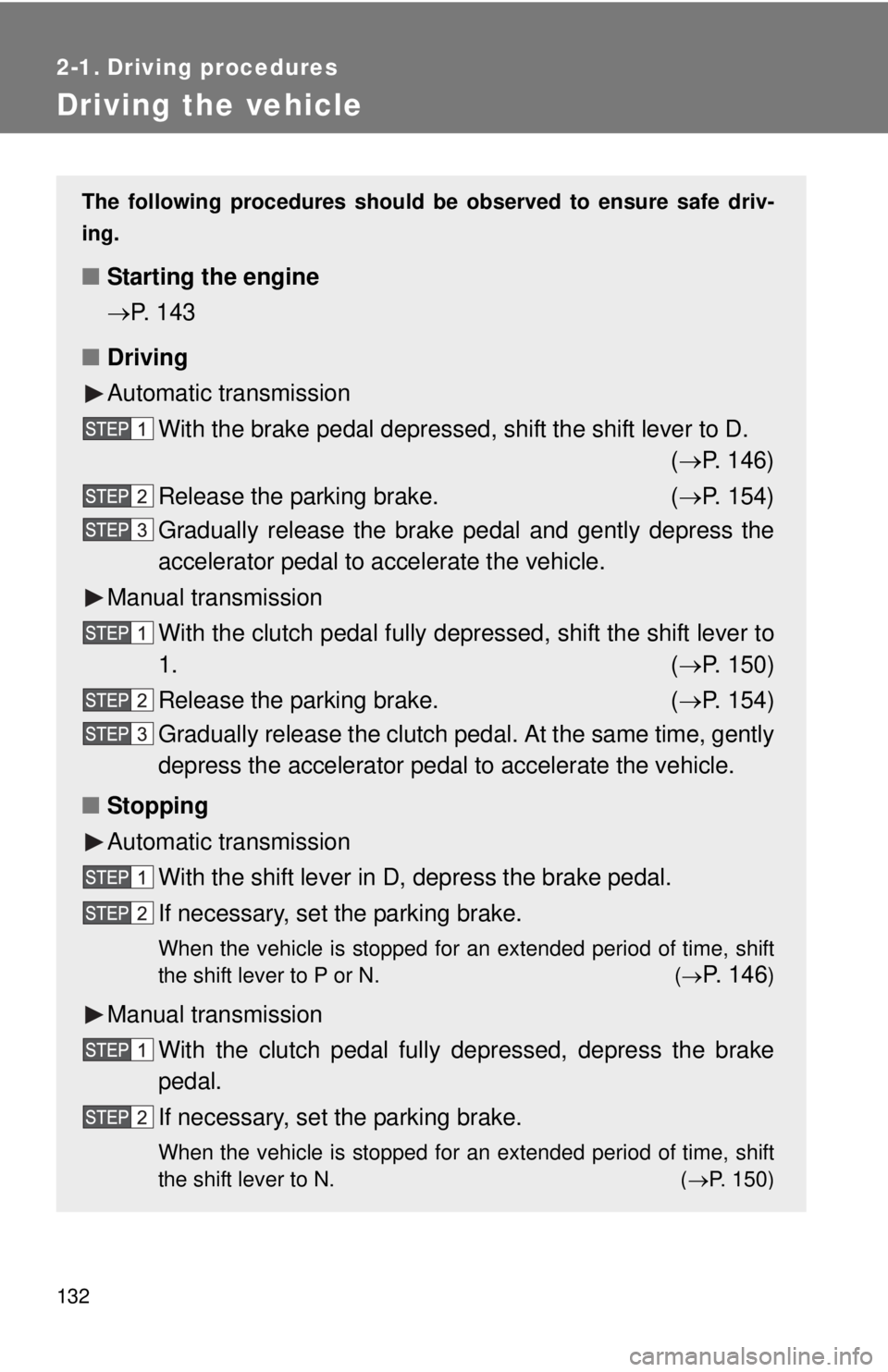
132
2-1. Driving procedures
Driving the vehicle
The following procedures should be observed to ensure safe driv-
ing.
■ Starting the engine
P. 143
■ Driving
Automatic transmission
With the brake pedal depressed, shift the shift lever to D. ( P. 146)
Release the parking brake. ( P. 154)
Gradually release the brake pedal and gently depress the
accelerator pedal to accelerate the vehicle.
Manual transmission With the clutch pedal fully depressed, shift the shift lever to
1. ( P. 150)
Release the parking brake. ( P. 154)
Gradually release the clutch pedal. At the same time, gently
depress the accelerator pedal to accelerate the vehicle.
■ Stopping
Automatic transmission
With the shift lever in D, depress the brake pedal.
If necessary, set the parking brake.
When the vehicle is stopped for an extended period of time, shift
the shift lever to P or N. (
P. 1 4 6)
Manual transmission
With the clutch pedal fully depressed, depress the brake
pedal.
If necessary, set the parking brake.
When the vehicle is stopped for an extended period of time, shift
the shift lever to N. ( P. 150)
Page 133 of 628
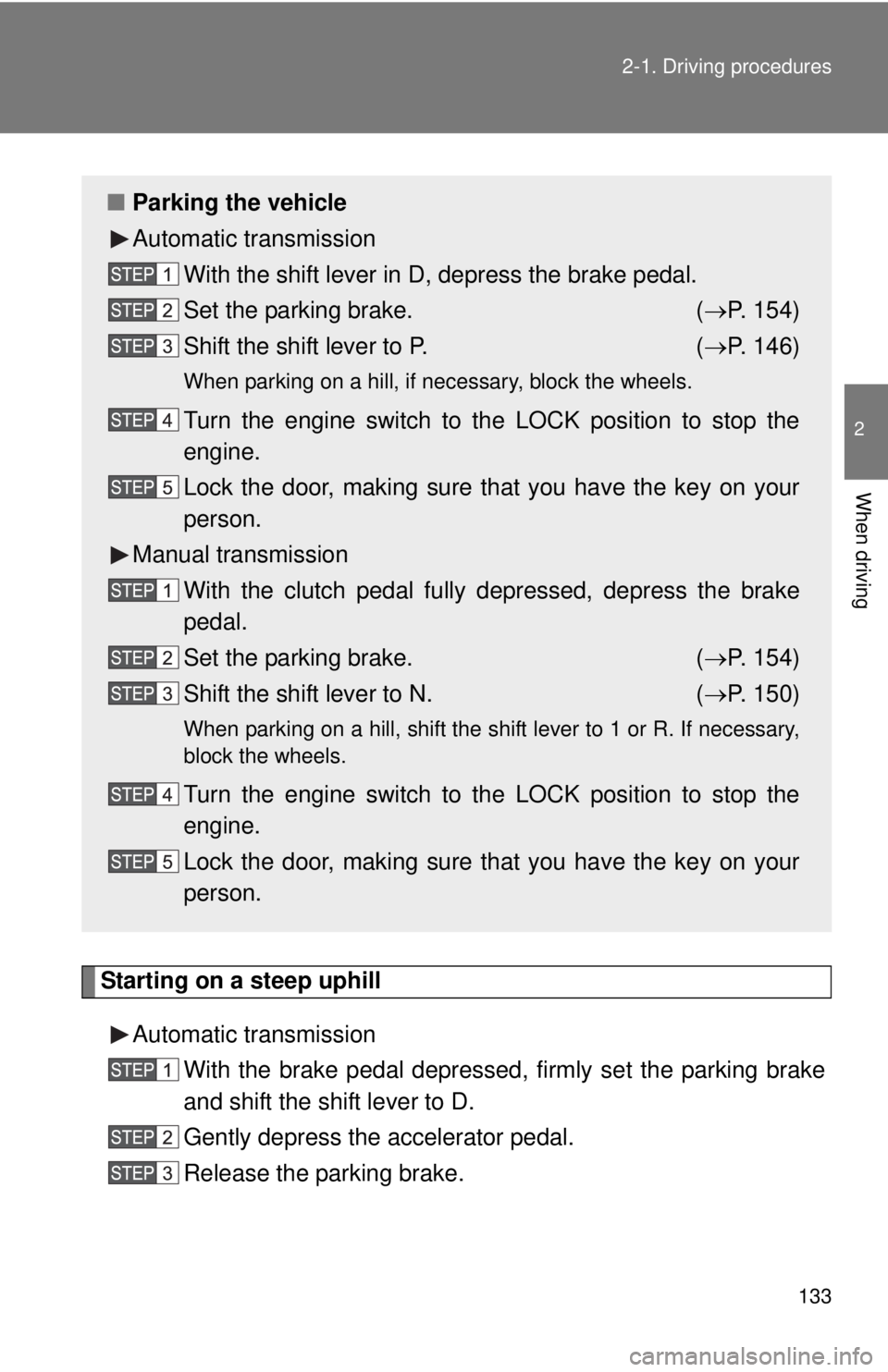
133
2-1. Driving procedures
2
When driving
Starting on a steep uphill
Automatic transmission With the brake pedal depressed, firmly set the parking brake
and shift the shift lever to D.
Gently depress the accelerator pedal.
Release the parking brake.
■Parking the vehicle
Automatic transmission
With the shift lever in D, depress the brake pedal.
Set the parking brake. ( P. 154)
Shift the shift lever to P. ( P. 146)
When parking on a hill, if necessary, block the wheels.
Turn the engine switch to the LOCK position to stop the
engine.
Lock the door, making sure that you have the key on your
person.
Manual transmission With the clutch pedal fully depressed, depress the brake
pedal.
Set the parking brake. ( P. 154)
Shift the shift lever to N. ( P. 150)
When parking on a hill, shift the shift lever to 1 or R. If necessary,
block the wheels.
Turn the engine switch to the LOCK position to stop the
engine.
Lock the door, making sure that you have the key on your
person.
Page 134 of 628

134 2-1. Driving procedures
Manual transmissionWith the parking brake firmly set and the clutch pedal fully
depressed, shift the shift lever to 1.
Lightly depress the accelerator pedal at the same time as
gradually releasing the clutch pedal.
Release the parking brake.
■Driving in the rain
●Drive carefully when it is raining, because visibility will be reduced, the
windows may become fogged-up, and the road will be slippery.
● Drive carefully when it starts to rain, because the road surface will be
especially slippery.
● Refrain from high speeds when driving on an expressway in the rain,
because there may be a layer of water between the tires and the road
surface, preventing the steering and brakes from operating properly.
■ Breaking in your new Toyota
To extend the life of the vehicle, the following precautions are recommended
to observe:
●For the first 200 miles (300 km):
Avoid sudden stops.
● For the first 500 miles (800 km):
Do not tow a trailer.
● For the first 1000 miles (1600 km):
• Do not drive at extremely high speeds.
• Avoid sudden acceleration.
• Do not drive continuously in the low gears.
• Do not drive slowly with the manual transmission in a high gear.
• Do not drive at a constant speed for extended periods.
■ Operating your vehicle in a foreign country
Comply with the relevant vehicle registration laws and confirm the availability
of the correct fuel. ( P. 555)
Page 136 of 628

136 2-1. Driving procedures
CAUTION
■When driving the vehicle
●Do not shift the shift lever to R while the vehicle is moving forward.
Doing so can damage the transmission and may result in a loss of vehicle\
control.
● Do not shift the shift lever to D (vehicles with an automatic transmission) or
1 (vehicles with a manual transmission) while the vehicle is moving back-
ward.
Doing so can damage the transmission and may result in a loss of vehicle\
control.
● Moving the shift lever to N while the vehicle is moving will disengage the
engine from the transmission. Engine braking is not available when N is
selected.
● During normal driving, do not turn off the engine. Turning the engine off
while driving will not cause loss of steering or braking control, but the
power assist to these systems will be lost. This will make it more difficult to
steer and brake, so you should pull over and stop the vehicle as soon as it
is safe to do so.
However, in the event of an emergency, such as if it becomes impossible
to stop the vehicle in the normal way: P. 544
● Use engine braking (downshift) to maintain a safe speed when driving
down a steep hill.
Using the brakes continuously may cause the brakes to overheat and lose
effectiveness. ( P. 146150)
● When stopped on an inclined surface, use the brake pedal and parking
brake to prevent the vehicle from rolling backward or forward and causing
an accident.
● Do not adjust the position of the steering wheel, the seat, or the inside or
outside rear view mirrors while driving.
Doing so may result in a loss of vehicle control that can cause accidents
that may result in death or serious injury.
● Always check that all passengers’ arms, heads or other parts of their bod-
ies are not outside the vehicle, as this may result in death or serious injury.
Page 140 of 628

140 2-1. Driving procedures
CAUTION
■When braking the vehicle
●Do not pump the brake pedal if the engine stalls.
Each push on the brake pedal uses up the reserve for the power-assisted
brakes.
● The brake system consists of 2 individual hydraulic systems: If one of the
systems fails, the other will still operate. In this case, the brake pedal
should be depressed more firmly than usual and braking distance
becomes longer.
Do not drive your vehicle with only a single brake system. Have your
brakes fixed immediately.
NOTICE
■When driving the vehicle
●Do not depress the accelerator and brake pedals at the same time during
driving. If the brake pedal is depressed while driving with the accelerator
pedal depressed, driving torque may be restrained.
Vehicles with a manual transmission
● Do not rest your foot on the clutch pedal while driving.
Doing so may cause clutch trouble.
● Do not use any gears other than the first gear when starting off and mov-
ing forward.
Doing so may damage the clutch.
● Do not use the clutch to hold the vehicle when stopping on an uphill grade.
Doing so may damage the clutch.
Vehicles with an automatic transmission
● Do not use the accelerator pedal or depress the accelerator and brake
pedals at the same time to hold the vehicle on a hill.
■ When parking the vehicle
On vehicles with an automatic transmission, always put the shift lever in P.
Failure to do so may cause the vehicle to move or the vehicle may acceler-
ate suddenly if the accelerator pedal is accidentally depressed.